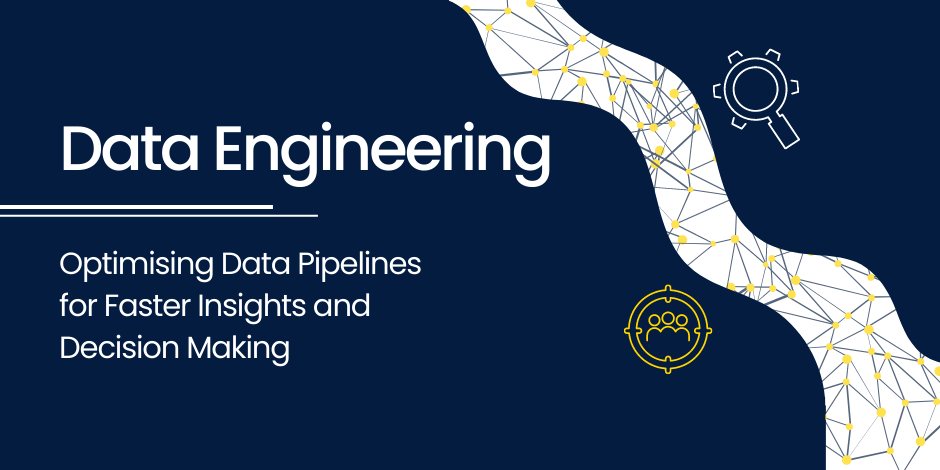Data Engineering: Optimising Data Pipelines for Faster Insights and Decision Making

Stay Informed With Our Weekly Newsletter
Receive crucial updates on the ever-evolving landscape of technology and innovation.
As the need for data analysis escalates in the digital age, the efficiency and necessity for optimising data pipelines in data engineering cannot be overstated. We delve into the significance of pipeline optimisation and the methods of enhancing their efficiency for expedited insights and decision-making.
Understanding the importance of data pipelines in data engineering
Data pipelines are pivotal in data engineering, providing a structured format for moving data from one station to another. Understanding their importance is the first step towards realising their optimisation needs.
Data pipelines are essential for ensuring efficiency and accuracy when handling large volumes of data. They are a reliable mechanism for automating the data flow, allowing organisations to process and analyse vast amounts of information systematically.
Key benefits include their ability to handle different types and formats of data. Whether structured data from databases, unstructured data from social media platforms, or semi-structured data from web scraping, pipelines can seamlessly integrate and transform these diverse data sources into a unified format.
Defining data pipelines
A data pipeline is a series of data processing steps where an input is subjected to a set of conditions or rules to generate an output. This encompasses various stages, from extraction, transformation, and loading of the data to the final process of interpretation and analysis.
Let’s delve deeper into the stages of a typical data pipeline:
- Data Extraction: This is the initial stage where data is collected from various sources such as databases, application programme interfaces, or external files. It involves identifying the relevant data and extracting it in a structured format.
- Data Transformation: Once the data is extracted, it often needs to be cleaned, standardised, and transformed into a consistent format. This stage involves data cleansing, normalisation, and aggregation to ensure data quality and consistency.
- Data Loading: After the data is transformed, it must be loaded into a target destination, such as a data warehouse or a database. This stage involves organising the transformed data into tables, schemas, or other suitable structures for efficient storage and retrieval.
The role of data pipelines in data engineering
At the core of data engineering lies the data pipeline, a tool that transforms raw data into a format suitable for analysis. Data pipelines facilitate informed decision-making and enable fast interpretations by streamlining data from multiple sources into a single, unified view.
One of the primary objectives of data engineering is to ensure that data is readily available and accessible for analysis. Data pipelines serve as the backbone of this process by automating the movement of data, reducing manual effort, and minimising the risk of errors.
Moreover, data pipelines enable organisations to implement real-time or near-real-time data processing. Organisations can gain useful insights and make data-driven decisions on time by continuously ingesting and processing data as it becomes available.
In addition to their role in data processing, data pipelines contribute to data governance and security. They provide a centralised mechanism for monitoring data flow, ensuring compliance with privacy regulations, and implementing data protection measures.
Furthermore, data pipelines can be designed to handle complex data workflows, incorporating advanced techniques such as data enrichment, data validation, and data deduplication. These capabilities enhance the quality and reliability of the data, leading to more accurate analysis and decision-making processes.
Data pipelines are an integral part of data engineering, enabling organisations to efficiently process, transform, and analyse large volumes of data. Data pipelines facilitate informed decision-making and drive business success by automating data movement and ensuring quality and consistency.
The need for optimising data pipelines

As variety, data volume, and velocity continue to rise, the need for optimisation in data pipelines is more pressing than ever. Enhancing the efficiency of data pipelines can lead to quicker insights, improved decision-making capabilities, and, ultimately, a competitive edge in the business landscape.
Data pipelines play a vital role in the modern data-driven world. They are responsible for the smooth data flow from various sources to the desired destinations.
However, as the complexity of data increases, so does the need for optimisation.
Data pipeline optimisation involves streamlining the data extraction, transformation, and loading process. It aims to eliminate bottlenecks, reduce redundancy, and improve overall performance.
By doing so, organisations can unlock the full potential of their data and gain a better understanding of their business.
The impact of inefficient data pipelines
Inefficient data pipelines can significantly hamper the ability of an organisation to draw timely insights from data.
This can lead to delayed decision-making, loss of opportunities, and reduced operational efficiency. Therefore, optimising data pipelines is of paramount importance.
When data pipelines are inefficient, it can result in data delays and inconsistencies. This means that decision-makers must wait longer to access the information they need, hindering their ability to respond quickly to market changes or customer demands.
Moreover, inefficient pipelines can introduce errors and inaccuracies in the data, leading to flawed analysis and misguided decisions.
Furthermore, inefficient data pipelines can strain IT resources and increase costs. When pipelines are not optimised, they may require excessive storage, processing power, or network bandwidth, leading to unnecessary expenses.
By optimising data pipelines, organisations can reduce resource wastage and allocate their IT infrastructure more effectively.
Benefits of optimising data pipelines
Optimised data pipelines can radically improve the speed and accuracy of data analysis. By reducing redundancy and enhancing data quality, such pipelines can support more efficient data management and lead to more precise, reliable insights.
One of the key benefits of optimised data pipelines is faster data processing. By eliminating unnecessary steps and improving data flow, organisations can accelerate the time it takes to extract insights from raw data.
This allows decision-makers to act swiftly and stay ahead of the competition in today’s fast-paced business environment.
Moreover, optimised data pipelines can enhance data quality. By implementing data cleansing techniques, removing duplicates, and ensuring data consistency, organisations can trust the accuracy and reliability of their data.
This, in turn, leads to more informed decision-making and reduces the risk of making choices based on faulty information.
Furthermore, optimised data pipelines enable scalability. As data volumes grow, organisations must ensure their pipelines can handle the increased load.
By optimising the pipeline architecture and implementing scalable solutions, organisations can future-proof their data infrastructure and avoid performance bottlenecks.
The need for optimisation in data pipelines is increasingly important. Inefficient pipelines can hinder an organisation’s ability to leverage data effectively, leading to missed opportunities and reduced competitiveness.
On the other hand, optimised pipelines can unlock the full potential of data, enabling faster insights, improved decision-making, and a stronger position in the market.
Steps to optimise data pipelines for faster insights

The following steps provide actionable insights into optimising your data pipelines for faster insights and improved decision-making.
Data cleaning and preparation
Data cleaning and preparation is a crucial step in optimising data pipelines. By removing inconsistencies, duplications, and missing values, you can ensure your data is of the highest quality, facilitating faster and more accurate analysis.
Implementing data transformation techniques
Applying appropriate data transformation techniques such as normalisation, standardisation, and bucketing can be crucial in optimising data pipelines. These techniques can help convert raw data into a more suitable format for analysis, thereby facilitating faster insights.
Streamlining data integration
Optimising the data integration process can drastically improve the speed and efficiency of data pipelines. Organisations can reduce redundancy and streamline data analysis by efficiently combining data from different sources.
Leveraging advanced technologies for data pipeline optimisation
In addition to traditional techniques, leveraging advanced technologies can take data pipeline optimisation to a new level. Tools such as machine learning, artificial intelligence, and cloud-based options can help you get the most out of your data pipelines.
The role of machine learning and artificial intelligence
Machine learning and artificial intelligence have the potential to revolutionise data pipeline optimisation. By predicting patterns and personalising user experiences, these technologies can enhance data processing and facilitate faster insights and decision-making.
Cloud-based solutions for data pipelines
Cloud-based solutions can provide scalable, cost-effective, and highly efficient methods for optimising data pipelines. With their ability to handle large volumes of data and provide real-time analytics, cloud solutions have emerged as a go-to avenue for data pipeline optimisation.
Case studies of effective data pipeline optimisation

Leveraging case studies from diverse sectors can provide insights into effective data pipeline optimisation practices.
Success stories from the tech industry
There are numerous examples in the tech industry where optimised data pipelines have provided a competitive edge. For instance, tech giants like Amazon and Google leverage optimised data pipelines to deliver personalised user experiences and actionable insights in real-time.
Lessons from the healthcare and finance sectors
Healthcare and finance sectors also provide compelling case studies in data pipeline optimisation.
By leveraging optimised data pipelines, these sectors have seen improved patient outcomes and financial efficiency, showcasing the importance of data pipeline optimisation in diverse industry settings.
Conclusion
Regardless of your industry, optimising data pipelines is crucial for any data-driven organisation. With the right approach and tools, you can maximise the potential of your data pipelines and drive faster insights for effective decision-making.
Are you interested in learning more about the world of data optimisation?
The Institute of Data offers comprehensive, industry-aligned courses that will equip you with the knowledge and experience needed to excel.
Take advantage of the free career consultations we offer with our local team to discuss your options.



